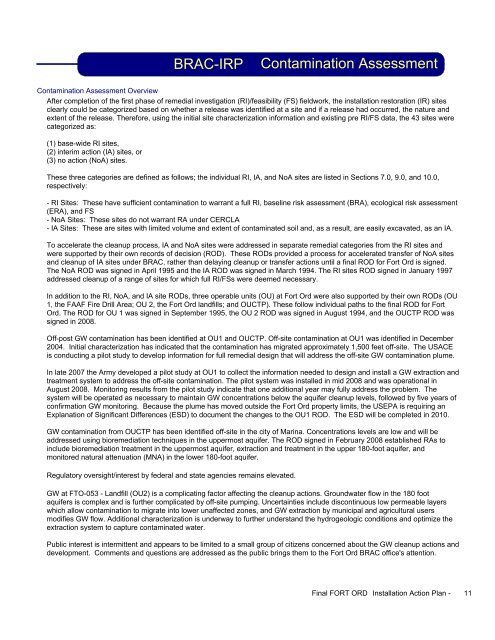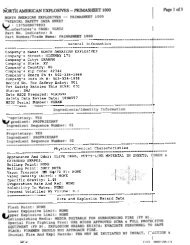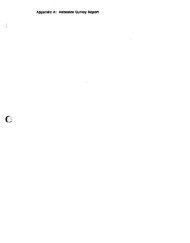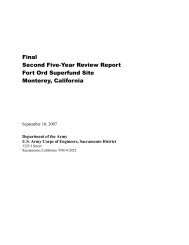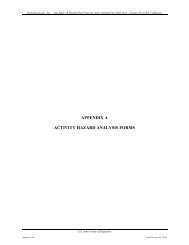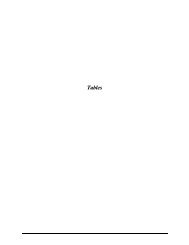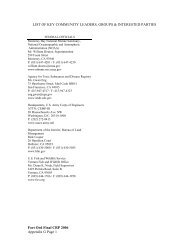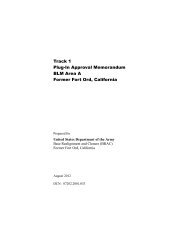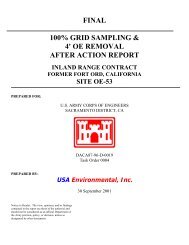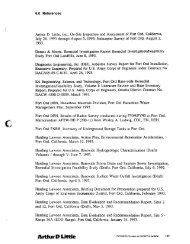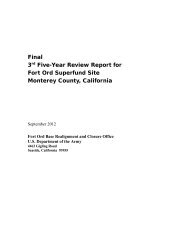FY2009 - Former Fort Ord - Environmental Cleanup
FY2009 - Former Fort Ord - Environmental Cleanup
FY2009 - Former Fort Ord - Environmental Cleanup
You also want an ePaper? Increase the reach of your titles
YUMPU automatically turns print PDFs into web optimized ePapers that Google loves.
BRAC-IRP<br />
Contamination Assessment<br />
Contamination Assessment Overview<br />
After completion of the first phase of remedial investigation (RI)/feasibility (FS) fieldwork, the installation restoration (IR) sites<br />
clearly could be categorized based on whether a release was identified at a site and if a release had occurred, the nature and<br />
extent of the release. Therefore, using the initial site characterization information and existing pre RI/FS data, the 43 sites were<br />
categorized as:<br />
(1) base-wide RI sites,<br />
(2) interim action (IA) sites, or<br />
(3) no action (NoA) sites.<br />
These three categories are defined as follows; the individual RI, IA, and NoA sites are listed in Sections 7.0, 9.0, and 10.0,<br />
respectively:<br />
- RI Sites: These have sufficient contamination to warrant a full RI, baseline risk assessment (BRA), ecological risk assessment<br />
(ERA), and FS<br />
- NoA Sites: These sites do not warrant RA under CERCLA<br />
- IA Sites: These are sites with limited volume and extent of contaminated soil and, as a result, are easily excavated, as an IA.<br />
To accelerate the cleanup process, IA and NoA sites were addressed in separate remedial categories from the RI sites and<br />
were supported by their own records of decision (ROD). These RODs provided a process for accelerated transfer of NoA sites<br />
and cleanup of IA sites under BRAC, rather than delaying cleanup or transfer actions until a final ROD for <strong>Fort</strong> <strong>Ord</strong> is signed.<br />
The NoA ROD was signed in April 1995 and the IA ROD was signed in March 1994. The RI sites ROD signed in January 1997<br />
addressed cleanup of a range of sites for which full RI/FSs were deemed necessary.<br />
In addition to the RI, NoA, and IA site RODs, three operable units (OU) at <strong>Fort</strong> <strong>Ord</strong> were also supported by their own RODs (OU<br />
1, the FAAF Fire Drill Area; OU 2, the <strong>Fort</strong> <strong>Ord</strong> landfills; and OUCTP). These follow individual paths to the final ROD for <strong>Fort</strong><br />
<strong>Ord</strong>. The ROD for OU 1 was signed in September 1995, the OU 2 ROD was signed in August 1994, and the OUCTP ROD was<br />
signed in 2008.<br />
Off-post GW contamination has been identified at OU1 and OUCTP. Off-site contamination at OU1 was identified in December<br />
2004. Initial characterization has indicated that the contamination has migrated approximately 1,500 feet off-site. The USACE<br />
is conducting a pilot study to develop information for full remedial design that will address the off-site GW contamination plume.<br />
In late 2007 the Army developed a pilot study at OU1 to collect the information needed to design and install a GW extraction and<br />
treatment system to address the off-site contamination. The pilot system was installed in mid 2008 and was operational in<br />
August 2008. Monitoring results from the pilot study indicate that one additional year may fully address the problem. The<br />
system will be operated as necessary to maintain GW concentrations below the aquifer cleanup levels, followed by five years of<br />
confirmation GW monitoring. Because the plume has moved outside the <strong>Fort</strong> <strong>Ord</strong> property limits, the USEPA is requiring an<br />
Explanation of Significant Differences (ESD) to document the changes to the OU1 ROD. The ESD will be completed in 2010.<br />
GW contamination from OUCTP has been identified off-site in the city of Marina. Concentrations levels are low and will be<br />
addressed using bioremediation techniques in the uppermost aquifer. The ROD signed in February 2008 established RAs to<br />
include bioremediation treatment in the uppermost aquifer, extraction and treatment in the upper 180-foot aquifer, and<br />
monitored natural attenuation (MNA) in the lower 180-foot aquifer.<br />
Regulatory oversight/interest by federal and state agencies remains elevated.<br />
GW at FTO-053 - Landfill (OU2) is a complicating factor affecting the cleanup actions. Groundwater flow in the 180 foot<br />
aquifers is complex and is further complicated by off-site pumping. Uncertainties include discontinuous low permeable layers<br />
which allow contamination to migrate into lower unaffected zones, and GW extraction by municipal and agricultural users<br />
modifies GW flow. Additional characterization is underway to further understand the hydrogeologic conditions and optimize the<br />
extraction system to capture contaminated water.<br />
Public interest is intermittent and appears to be limited to a small group of citizens concerned about the GW cleanup actions and<br />
development. Comments and questions are addressed as the public brings them to the <strong>Fort</strong> <strong>Ord</strong> BRAC office's attention.<br />
Final FORT ORD Installation Action Plan - 11


